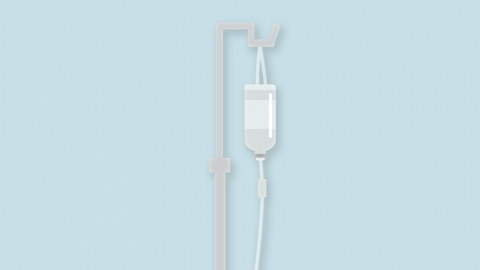What to do if the intravenous infusion vessel becomes hardened
Generally, the hardening of a blood vessel at the intravenous (IV) infusion site may be caused by factors such as excessively rapid infusion speed, repeated irritation at the puncture site, phlebitis, local thrombosis, or periphlebitis. It is recommended to seek timely medical consultation to determine the exact cause, followed by improvements under a doctor's guidance through local care, medication, and other methods. The detailed explanations are as follows:

1. Excessively Rapid Infusion: A large volume of fluid infused rapidly into the blood vessel over a short period can increase the pressure on the vessel wall, reducing its elasticity and gradually causing hardening, commonly seen when administering high-concentration medications. Immediately inform medical staff to slow the infusion rate, adjusting the drip speed according to the nature of the solution and the patient's tolerance to avoid continuous high-pressure stimulation on the vessel.
2. Repeated Irritation at the Puncture Site: Multiple punctures in the same vessel or pulling of adhesive tape during catheter fixation can damage the vessel wall, leading to hyperplasia and hardening, often seen in patients undergoing long-term infusions. Attempt to rotate puncture sites by selecting different vessels, minimize movement at the puncture site after insertion, and handle adhesive tape gently during changes to avoid pulling on the vessel.
3. Phlebitis: Intravenous inflammation may occur due to irritation from infused medications or improper aseptic techniques, causing redness, swelling, hardening of the vessel wall, and pain. Patients should follow medical advice to apply topical medications such as mucopolysaccharide polysulfate cream, heparin sodium cream, or diclofenac diethylamine gel to the affected area to promote inflammation resolution. Elevating the affected limb can also help reduce swelling.
4. Local Thrombosis: Injury to the vessel endothelium during infusion may lead to blood coagulation and thrombus formation, causing the vessel to harden and feel cord-like upon palpation, possibly accompanied by localized swelling. Follow medical instructions to use anticoagulant and thrombolytic agents such as low molecular weight heparin calcium injection, warfarin sodium tablets, or rivaroxaban tablets to prevent thrombus enlargement.
5. Periphlebitis: Inflammation extending from the vein to surrounding tissues can cause tissue fibrosis, pulling on the vessel and causing hardening, often accompanied by increased local skin temperature. Follow medical advice to use medications such as ceftriaxone sodium for injection, metronidazole injection, or ibuprofen sustained-release capsules to control infection and relieve pain. Hot compresses may also be used in combination to improve local blood circulation and aid tissue repair.
In daily life, keep the puncture site clean and dry to avoid moisture and prevent infection. During infusion, appropriate movement of the distal extremity on the punctured side may help promote venous return. In terms of diet, reduce consumption of spicy foods and increase intake of fresh fruits and vegetables rich in vitamins. Comprehensive nursing care can help restore vascular elasticity and maintain venous health.







